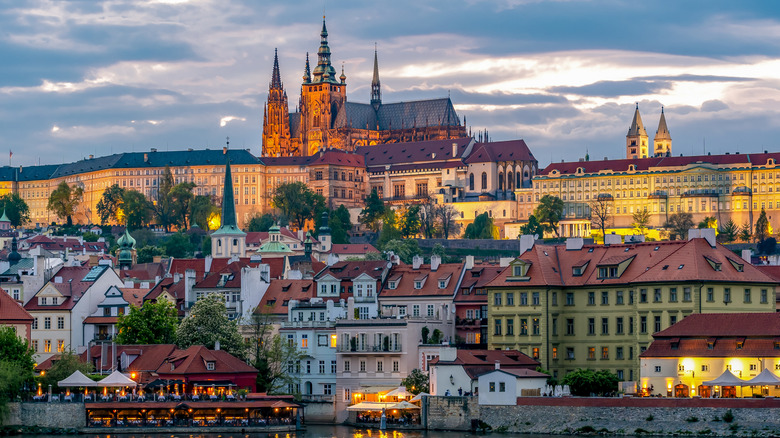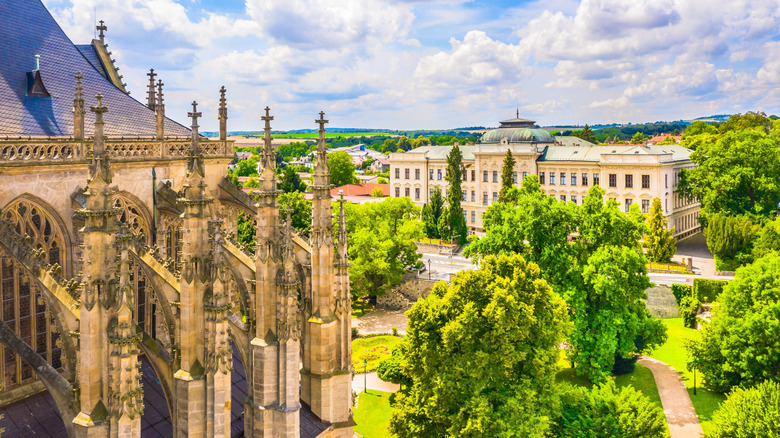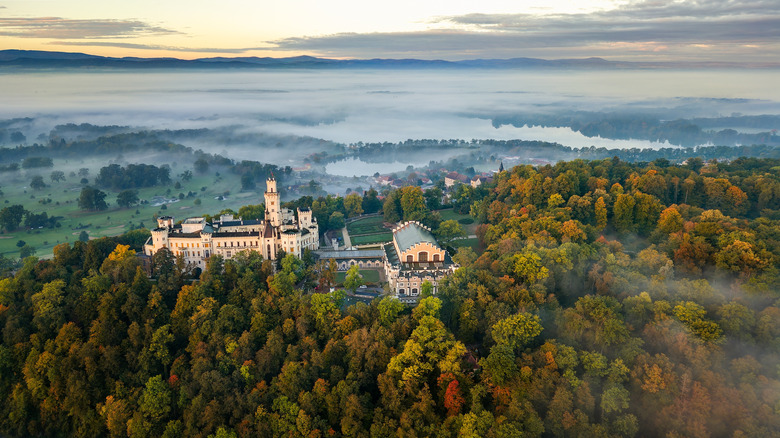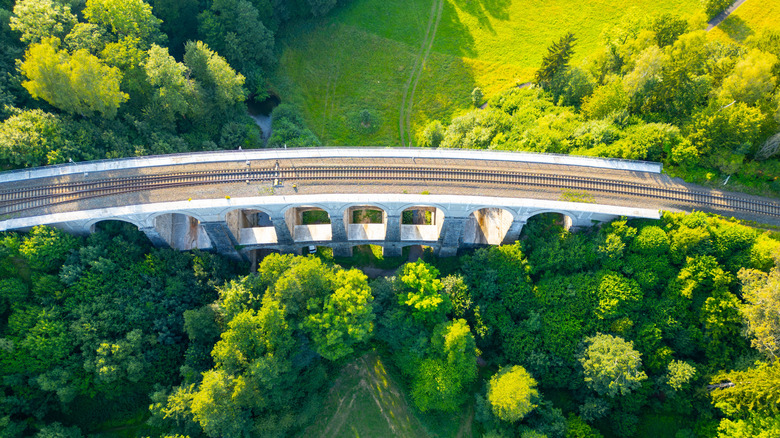One Of Europe's Safest Countries Is Home To Dazzling Cities, Fairytale Castles, And Friendly Locals
Everyone warns you about pickpockets when traveling in Europe, especially in cities like Rome, Barcelona, or Paris; in fact, some people even joke about the fact that they didn't get robbed. But, of course, that stereotype doesn't apply to the entire continent, and certainly not when you're in Czechia. Sure, you should always stay aware of your surroundings because all kinds of people exist everywhere, but compared to other top tourist destinations, you'll definitely feel safer here.
According to the Global Peace Index, Czechia ranks as the 12th safest country worldwide, with a score of 1.46. If you're not familiar with the GPI scale, it ranges from 1 to 5, with 1 meaning "very peaceful" and 5 meaning "extremely violent." What's more, Czechia has consistently ranked in the top 10 from 2009 to 2022. Now, pair that safety with amazing cities, legendary castles, and, as Rick Steves puts it, the best beer in all of Europe, and you've got yourself a fantastic, low-stress vacation.
Beyond the stunning sights and safe travel experiences, the Czech people can make your stay even better. Locals are typically kind, welcoming, and willing to help. They might seem a bit reserved at first, but that's just because many aren't confident in their English. Once you start a conversation, they tend to open up and are happy to share recommendations. A 2024 study by Remitly ranked Czechia as the 12th friendliest country based on traits like kindness and agreeableness. People here are polite and respectful, always on time, and take commitments seriously, but at the same time, they know how to enjoy life; work is important, but so is free time, and there is a strong culture of relaxation and balance. Whether you're ordering a beer, asking for directions, or chatting with someone at a cafe, expect a mix of warmth and politeness from locals.
No two Czech cities feel the same
Each city in Czechia has its own charm, but some places truly stand out. Naturally, Prague is an absolute must-visit; home to the iconic Charles Bridge, the capital city is a real-life fairytale locale, especially in winter when the Christmas markets light up the streets. The Astronomical Clock is an Instagram-worthy pic for your social media, and Old Town Square might just be the prettiest in Europe. The quirky Dancing House is a modern contrast against the city's skyline, but the real showstopper is Prague Castle, an awe-inspiring architectural wonder. As the largest castle complex in the world, it took around six centuries to complete, and climbing its spiral staircase rewards you with incredible views.
Make sure to check out neighborhoods like Žižkov, Vinohrady, and Karlin to discover the real Prague, and for a fascinating day trip, head to the under-the-radar Kutná Hora. This medieval town has plenty of eerie and beautiful sights. The famous Sedlec Ossuary, or Church of Bones, is a haunting yet mesmerizing place decorated with human remains — even the chandelier. If that's too dark for your taste, St. Barbara's Cathedral offers a more traditional but equally extraordinary highlight; this UNESCO World Heritage Site boasts a striking Gothic design and soaring arches. Strolling through Kutná Hora, you'll also come across quaint spots like the Italian Court and Stone Fountain.
Brno, Czechia's second-largest city, is a hidden gem for foodies and history buffs alike. Be sure to visit landmarks like the Cathedral of St. Peter and Paul, Moravian Karst, and Špilberk Castle on your itinerary. Other cities to check out include Karlovy Vary, a popular spa town that was featured in "Last Holiday"; Český Krumlov, a storybook-like small town and the country's second most-visited city; and Olomouc, a lesser-known treasure of Baroque architecture.
Czechia's medieval castles aren't so far, far away
Czechia is a dream destination for castle lovers, with more than 2,000 of the massive buildings scattered across the country — that's the most in Europe. You've probably already heard of Prague Castle, but venture beyond the capital and you'll find even more masterpieces. One of the most famous is Karlštejn Castle, a Gothic fortress built in the 14th century by Emperor Charles IV. Sitting atop a hill, this castle was designed to protect royal jewels; today, you can climb its towers to experience surreal views of the Czech countryside. Don't miss the Chapel of the Holy Cross inside, where semi-precious stones and centuries-old frescoes create a magical glow.
Hluboká Castle in South Bohemia is another must-see. If you think that the style doesn't really match the rest of the country's Gothic structures, it's because this one is inspired by England's Windsor Castle. Wander through its lavish halls, admire the intricate woodwork, and stroll along the manicured gardens, enjoying aristocratic elegance at its finest. Meanwhile, old-world charm and historic intrigue make Český Krumlov Castle a place that belongs on every traveler's list. Located above the Vltava River, this UNESCO-listed site is a gorgeous combination of Renaissance, Baroque, and Rococo styles. Make sure to roam through its 18th-century theater, which is one of the best-preserved of its kind on the continent.
For something more rugged, Loket Castle is a medieval stronghold rising dramatically over the Ohře River. Its stone walls, imposing watchtowers, and ancient interiors transport you back to the Middle Ages. Although Europe has countless fairytale-like hidden castles, Czechia might just be the top choice for seeing as many as possible in a single trip.
Where to base your Czechia trip
Czechia is small enough to make exploring it relatively stress-free, with most visitors starting their journey in Prague. Since Václav Havel Airport Prague (PRG) is the country's main international hub, it's also the most convenient place to begin your vacation. From here, you can easily travel to other cities and towns thanks to the country's well-connected transport system.
The train system is efficient, comfortable, and, unsurprisingly, the preferred way to get around. For instance, a two-and-a-half-hour train ride from Prague will take you to Brno. You can reach Kutná Hora in just about an hour, and Karlovy Vary is a three-hour train ride away. Olomouc is also close — just over two hours away by train — and a budget-friendly three-hour bus ride will take you to Český Krumlov.
Despite Prague being the typical starting point when visiting Czechia, other cities like Brno, Ostrava, and Karlovy Vary also have seasonal flights. Brno-Tuřany Airport, in particular, is a good option for travelers heading to the southeastern region, an area where you can visit towns that don't usually make travel bucket lists. However, no matter where you fly into, moving around the country by train remains one of the best and most scenic options, with Czech Railways (ČD), Leo Express, and RegioJet all offering domestic and international connections.



